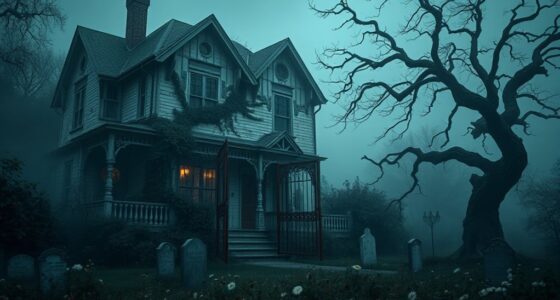Cold spots and hot spots show where heat either diminishes or concentrates within a system. Hot spots indicate areas with excess heat or energy buildup, often pointing to inefficiencies or potential damage, especially in electronics or industrial processes. Cold spots reveal zones of heat loss or poor transfer, often caused by insulation issues or airflow problems. Recognizing these areas helps optimize performance and prevent failures—exploring further will uncover how to manage these zones effectively.
Key Takeaways
- Hot spots are areas with concentrated heat due to localized energy sources or inefficiencies.
- Cold spots indicate regions of heat loss or poor transfer, often caused by insulation issues or airflow disruptions.
- Recognizing hot and cold spots helps optimize system performance and prevent damage or failures.
- They occur in natural environments and engineered systems, providing insights into heat flow patterns.
- Identifying these zones supports system diagnostics, maintenance, and efficiency improvements.

Understanding cold spots and hot spots is essential because they reveal where energy, heat, or other factors concentrate or diminish within a system. When you observe these areas, you’re fundamentally uncovering thermodynamic anomalies that disrupt the usual heat transfer patterns. These anomalies can occur in various contexts—from natural environments like the Earth’s crust to engineered systems such as HVAC setups or electronic devices. Recognizing these zones helps you diagnose issues, optimize performance, and prevent failures by understanding how heat flows and where it accumulates or dissipates unexpectedly. Heat transfer patterns are critical to understanding the dynamics within these systems.
Hot spots are regions where heat transfer intensifies, often due to localized energy sources or inefficient dissipation. In thermal systems, these areas indicate that heat isn’t dispersing evenly, leading to higher temperatures than surrounding zones. For example, in electronics, hot spots develop when components draw more current or generate more heat than others, creating uneven heat transfer patterns. This uneven distribution can cause damage or reduced lifespan if not managed properly. Similarly, in industrial applications, hot spots can signal process inefficiencies or equipment malfunctions, alerting you to areas requiring cooling or maintenance.
Conversely, cold spots are areas where heat diminishes or is absent, revealing where energy escapes or isn’t transferred effectively. These zones often result from insulation flaws, airflow interruptions, or material differences that hinder heat transfer. In a building, cold spots might be areas with poor insulation, leading to drafts and increased energy consumption. In geothermal studies, cold spots can indicate zones of lower temperature, which might suggest the presence of natural barriers or fluid movement disrupting typical heat transfer patterns. Identifying these cold zones allows you to improve insulation, streamline airflow, or adjust system parameters to restore more uniform heat distribution.
Frequently Asked Questions
How Do Thermal Cameras Detect Cold and Hot Spots?
Thermal cameras detect cold and hot spots through infrared imaging, which captures the heat emitted by objects. You see temperature differences as variations in color on the camera’s display. By analyzing these images, you perform temperature mapping, identifying areas that are unusually cold or hot. This process helps you pinpoint issues like insulation leaks or overheating components quickly and accurately, without any physical contact.
What Industries Most Rely on Identifying Cold and Hot Spots?
You rely heavily on thermal imaging in industries like retail merchandising and agricultural monitoring to spot subtle issues early. These sectors use hot and cold spot detection to optimize product placement, reduce energy costs, and monitor crop health. By identifying temperature variations, you can enhance efficiency and safety, ensuring quality and consistency. Thermal cameras become your silent allies, revealing insights that help you make smarter, faster decisions.
Can Cold Spots Indicate Potential Safety Hazards?
Yes, cold spots can indicate potential safety hazards. You should watch for them because they often signal insulation issues or areas where fire hazards could develop. Cold spots may suggest drafts, leaks, or moisture buildup, which can weaken building structures or increase fire risks. Addressing these spots promptly helps prevent accidents, improve energy efficiency, and ensure a safer environment for everyone. Always investigate cold spots thoroughly to identify underlying safety concerns.
How Do Environmental Factors Affect Hot and Cold Spot Detection?
Environmental factors, like ambient temperature and material properties, can really throw off your hot and cold spot detection. You might think your sensors are accurate, but sudden temperature shifts or materials that insulate or conduct heat unpredictably can create false readings. Ironically, the environment’s complexity demands that you consider these factors carefully—ignoring them might lead you to chase phantom spots instead of real issues.
Are There Any Health Risks Associated With Hot Spots?
Hot spots can pose health risks and safety hazards if you’re exposed to excessive heat for too long. You might experience burns, heat exhaustion, or dehydration, especially in industrial or outdoor settings. It’s essential to monitor temperatures and take precautions, like wearing protective gear or staying hydrated. Ignoring these risks can lead to serious health issues, so always prioritize safety when working near or around hot spots.
Conclusion
Now that you understand hot spots and cold spots, you see how they shape your environment like unseen hands guiding energy flow. Recognizing these areas helps you optimize spaces, conserve resources, and improve comfort. Think of them as the heartbeat of a room—pulsing with warmth or whispering coolness. By tuning into these spots, you become a conductor of comfort, orchestrating a balanced, more efficient space where every part sings in harmony.









